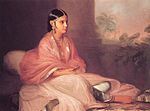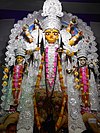Kantha

Kantha, also spelled kanta or qanta, is a type of embroidery craft in Bangladesh and eastern regions of India, particularly in the Indian states of West Bengal, Tripura and Odisha. In Odisha, old saris are stacked on each other and hand-stitched to make a thin piece of cushion. This is normally used above a bed cushion or instead of a cushion.[1] "Kantha saris" are traditionally worn by women in Bengal region.[2] In these days, embroidery is stitched, popularly known as 'kantha stitched", on sari, kurta (or panjabi) and churidar and many other garments and gaining popularity due to their aesthetic value and handmade characteristics.
Kantha stitching is also used to make simple quilts, commonly known as nakshi kantha. Women in Bengal typically use old saris and cloth and layer them with kantha stitching to make a light blanket, throw, or bedspread, especially for children. Kantha is very popular with tourists visiting the Bengal region of the Indian subcontinent.
Weave
[edit]
Kantha is a form of embroidery often practised by rural women. The traditional form of Kantha embroidery was done with soft dhotis and saris, with a simple running stitch along the edges. Depending on the use of the finished product they were known as Lepkantha or Sujni Kantha.
The embroidered cloth has many uses including shawls, covers for mirrors, boxes, and pillows. In some cases, the entire cloth is covered with running stitches, employing beautiful motifs of flowers, animals, birds and geometrical shapes, as well as themes from everyday activities. The stitching on the cloth gives it a slightly wrinkled, wavy effect. Contemporary kantha is applied to a wider range of garments such as sarees, dupatta, shirts for men and women, bedding and other furnishing fabrics, mostly using cotton and silk. Modern Kantha-stitch craft industry involves a very complex multi-staged production model.[3]


See also
[edit]References
[edit]- ^ India. Office of the Registrar General (1962). Census of India, 1961: Orissa. Manager of Publications.
- ^ "One stitch at a time - The Hindu". The Hindu. 25 September 2014.
- ^ Roy, Paramita and Sattwick Dey Biswas (2011). Opportunities and Constraints of the Kantha-stitch craftswomen in Santiniketan: a value chain analysis. Journal of Social Work and Social Development (ISSN 2229-6468). pp. 5–9.
Further reading
[edit]- The Art of Kantha embroidery, by Niaz Zaman. University Press, 1993. ISBN 984-05-1228-5.
- Jasleen Dhamija (2004). Asian embroidery. Abhinav Publications. ISBN 81-7017-450-3.
- Kantha: the embroidered quilts of Bengal, by Darielle Mason, Pika Ghosh, Katherine Hacker, Anne Peranteau. Yale University Press, 2010. ISBN 0300154429.
- Kantha, by John Gillow, Pratapaditya Pal, Courtenay McGowen, and Rob Sidner. Mingei International Museum and Radius Books, 2017. ISBN 9781942185192.
- Kantha Work, by Juby Aleyas Koll. Sarah's Hand Embroidery Tutorials, 2021.
- Indian culture stubs
- South Asia stubs
- Asian folk art
- Arts in Bangladesh
- Bangladeshi art
- Bangladeshi handicrafts
- Bangladeshi clothing
- Beds
- Bedding
- Blankets
- Culture of Bengal
- Culture of West Bengal
- Embroidery in India
- Embroidery stitches
- Geographical indications in West Bengal
- Indian clothing
- Indian handicrafts
- Linens
- Mattresses
- Needlework
- Notions (sewing)
- Ornaments
- Portable furniture
- Quilting
- Textile arts
- Textile arts of India
- Textile industry of India
- Textile techniques







